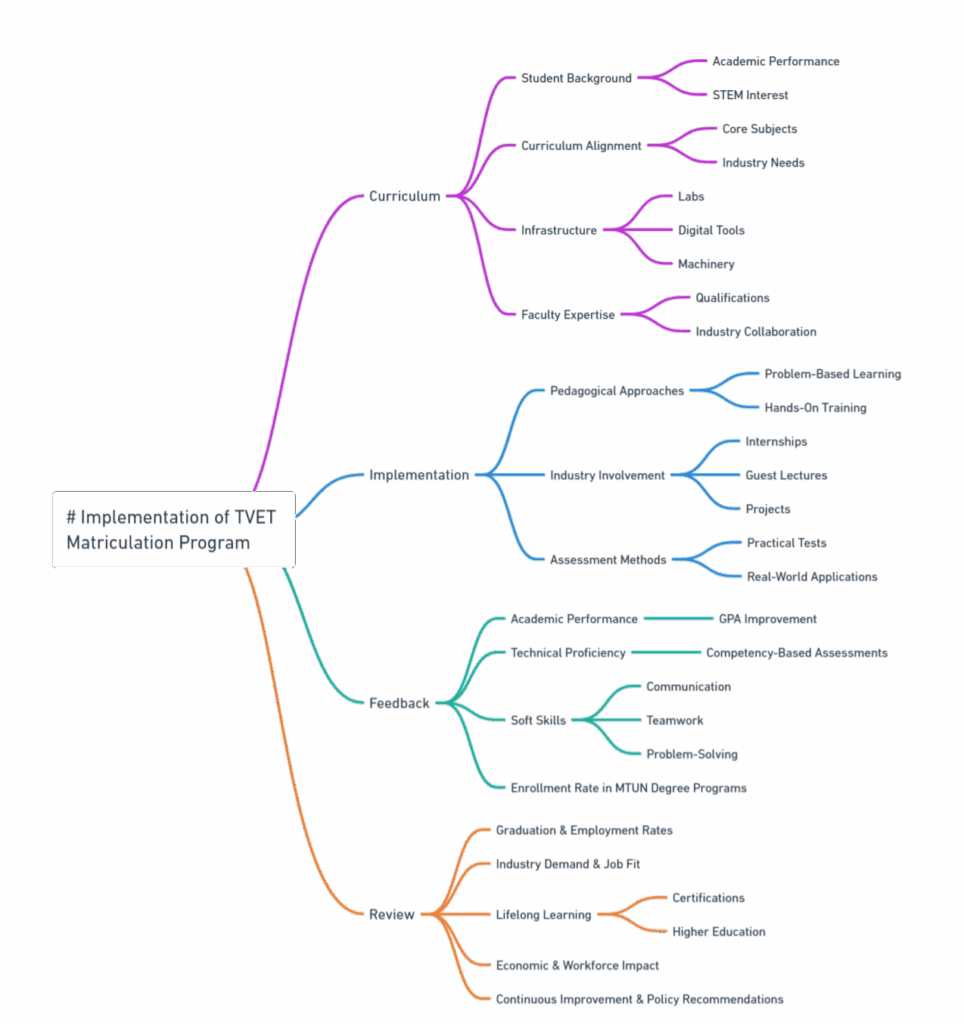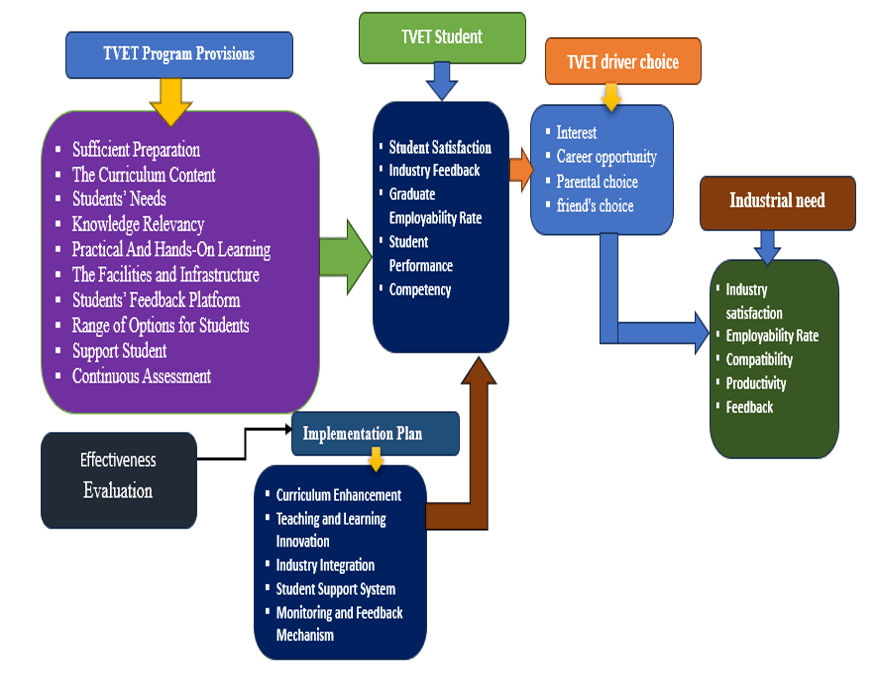Abstract
Technical Vocational Education and Training (TVET) has long been the central pillar in producing highly skilled human capital in technical and vocational fields in Malaysia. In 2023, the TVET matriculation curriculum was introduced in Malaysian education to meet the growing demand for TVET in the country. However, concerns persist regarding its effectiveness in preparing students for their career advancement. This paper summarizes the findings based on the survey instrument that was distributed to the first batch of students who took the TVET matriculation program. For the survey, 162 questionnaires were distributed. The analysis was conducted based on 149 valid questionnaires, with a response rate of 92%, obtained through a rigorous selection process. The results from the analysis show that career opportunities were the main factor in driving students to choose this program, with 49% of respondents emphasizing this factor. From an academic perspective, 75.2% of the students had a background in pure science during secondary school, indicating an interest and inclination towards technical disciplines. Meanwhile, 40.9% of students stated interest as the main factor influencing their choice. These results show that TVET continues to be a relevant choice among students who want to build a strong career.
Keywords: TVET, TVET Matriculation Curriculum, Career Advancement, Questionnaire Instrument, TVET Model
1 Introduction
TVET plays a pivotal role in producing a skilled workforce that aligns with Malaysia’s industrial and economic needs. However, the extent to which these competencies translate into higher education preparedness remains uncertain. This study addresses this gap by providing a comprehensive assessment of TVET matriculation graduates’ readiness for degree programs, offering insights into curriculum standardization, student support strategies, and policy recommendations to enhance academic preparedness.
The assessment of TVET matriculation is also scientifically relevant as it provides empirical evidence on the effectiveness of vocational education systems in preparing students for the labor market (Zaini 2023). Given the increasing demand for skilled labor in rapidly evolving industries, evaluating TVET matriculation outcomes is essential for aligning educational outputs with labor market needs. Scientifically assessing TVET matriculation enables researchers and policymakers to measure competencies, identify gaps in training, and evaluate the alignment between curriculum content and occupational standards. This is supported by theories of human capital development, which posit that education and skills training enhance individual productivity and contribute to economic growth (Becker 1964). Furthermore, such assessments can inform the design of evidence-based interventions to improve educational quality and ensure equity in access to employable skills, especially in developing economies where TVET is often a key strategy for addressing youth unemployment.
Daud et al. (2024) affirm the importance of TVET education programs in equipping students with the necessary knowledge, skills, and competencies for higher education effectiveness. According to Hassan et al. (2019), competency development in TVET institutions relies on the integration of knowledge, skills, and attitudes, which are essential for academic and professional success.
The study aims to propose a TVET model that evaluates and enhances the effectiveness of the TVET matriculation program in preparing students for degree programs in Malaysia.
2 Literature Review
The Malaysian Technical University Network (MTUN) is a strategic alliance of four public technical universities in Malaysia, i.e., Universiti Tun Hussein Onn Malaysia (UTHM), Universiti Teknikal Malaysia Melaka (UTeM), Universiti Malaysia Perlis (UniMAP), and Universiti Malaysia Pahang Al-Sultan Abdullah (UMPSA). These institutions were established to elevate technical and engineering education in line with national development aspirations (Mustapha & Hussain 2022). Originally upgraded from polytechnics, these institutions focus on strengthening Malaysia’s technical workforce by offering industry-oriented undergraduate and postgraduate programs. MTUN plays a pivotal role in advancing TVET by emphasizing hands-on learning, industry collaboration, and skill-based education tailored to meet the demands of the Fourth Industrial Revolution (Wong & Abdullah 2025).
TVET is an educational approach that equips learners with practical skills, technical knowledge, and industry-oriented competencies, aimed at increasing employability and productivity in a rapidly changing economy. In Malaysia, TVET has been widely recognized as a key strategy for national development, especially given the country’s ambitions to transition into a high-income, knowledge-based economy (Hanafi et al. 2023). The Malaysian government has prioritized TVET in response to the demands of the Fourth Industrial Revolution (IR 4.0), necessitating a workforce proficient in automation, digital skills, and technical problem-solving (Amdan et al. 2024).
TVET programs emphasize the integration of theory and practice, preparing students to adapt to real-world scenarios and meet labor market demands. These programs aim to bridge the gap between education and employment by involving industry stakeholders in curriculum development and providing students with hands-on experience via internships and project-based learning (Baharuddin et al. 2024). Furthermore, TVET educators are increasingly encouraged to develop digital competencies to keep pace with technological advancements in teaching and learning processes (Hamdan et al. 2021). By equipping learners with job-ready skills and supporting lifelong learning, TVET stands as a transformative force in addressing youth unemployment, economic inequality, and workforce mismatches in Malaysia and beyond (Subramaniam et al. 2020).
Curriculum is broadly defined as the organized set of learning experiences provided by educational institutions to achieve specific academic and developmental goals. It serves as a foundation for what and how students are expected to learn and the outcomes expected at the end of a learning period. In essence, it is not merely a list of subjects or content but encompasses learning objectives, teaching strategies, assessment methods, and desired competencies. For the TVET matriculation program, five subjects are offered. They are Physics, Chemistry, Engineering Technology, Mathematics, and the TVET Project. The TVET matriculation program was offered at five polytechnics in Malaysia for the first time in 2023. This program serves as a pathway for students transitioning into MTUN degree programs. However, concerns persist regarding its effectiveness in preparing students for the academic and technical demands of MTUN degrees while meeting industry expectations. Therefore, the purpose of this study is to propose and evaluate a comprehensive TVET Model that measures the effectiveness of the TVET matriculation program in preparing students for higher education pathways in Malaysia. This objective is pursued through quantitative analysis of student feedback, collected via a structured questionnaire, to assess academic readiness, motivation factors, and curriculum relevance. This research aims to contribute actionable insights toward curriculum development, policy enhancement, and support systems that bolster student success in transitioning to degree-level education. Therefore, it is essential to study the effectiveness of the TVET matriculation program by examining students’ academic backgrounds, school types, awareness of TVET career opportunities, and preferences for specific engineering and technology-related programs (Ibrahim et al. 2025).
3 Methodology
This study adopted a quantitative research design to assess the academic preparedness of TVET matriculation graduates for MTUN degree programs. A structured questionnaire was utilized as the primary data collection instrument to gather information on students’ academic readiness, curriculum effectiveness, and challenges faced during the transition. This study utilized a structured questionnaire to evaluate students’ academic readiness, awareness of curriculum offerings, and career aspirations within the TVET Foundation Program. Divided into three key sections, the instrument gathered data on students’ prior knowledge of the program, motivations for enrollment, familiarity with the Malaysian Technical University Network (MTUN), and future academic intentions. It also explored career planning and perceptions of the program’s effectiveness through a mix of response formats, including binary, multiple-choice, ranking, and Likert scales. Validated through expert review and pilot testing, the questionnaire served as the basis for statistical analyses aimed at measuring how well the program supports students’ transition to higher education and the workforce. The questionnaire included both closed-ended and Likert-scale questions to facilitate measurable and statistically analyzable responses. The target population for this study consisted of TVET matriculation students enrolled in various TVET institutions in Malaysia. This paper summarizes the findings based on the survey instrument that was distributed to the first batch of students who took the TVET matriculation program. From the population of 240, a sample size was drawn using the Krejcie and Morgan table, yielding a sample size of 162. For the survey, 162 questionnaires were distributed. The analysis was conducted based on 149 valid questionnaires obtained through a rigorous selection process. This gives a response rate of 92%. To ensure the reliability and generalizability of findings, a sample size of 149 respondents was determined using appropriate sampling techniques. Participants were selected through random sampling to maintain representation across different TVET institutions. Data analysis involved descriptive statistical methods, including measures of central tendency (mean, median, mode), frequency distributions, and percentages, to summarize and interpret the data effectively. The findings from the analysis provided insights into the preparedness level of TVET students, helping to identify key areas requiring intervention for a smoother transition into MTUN degree programs. Further details regarding the questionnaire design can be found in Milala et al. (2025). Based on the paper, the survey was conducted from March 2024 until October 2024. The questionnaire is divided into three subsections. They are the demographic profile of the respondents, information regarding the respondents, and information regarding the TVET matriculation program.
In handling the unfilled questionnaires and outliers, a systematic approach was adopted to maintain the integrity and accuracy of the data analysis process. Firstly, unfilled questionnaires were identified upon collection, and efforts were made to minimize their impact on the dataset. Each unfilled questionnaire was carefully reviewed to ensure that missing data was accurately documented and accounted for during analysis. Secondly, outliers were identified through statistical methods such as z-scores or visualization techniques. Once identified, outliers were subjected to rigorous scrutiny to determine their validity and potential impact on the overall analysis. Outliers deemed to be genuine data points were retained, while those identified as errors or anomalies were either corrected or removed from the dataset, with careful consideration given to maintaining the representativeness and integrity of the data. This meticulous approach ensured that the analysis was conducted on a reliable dataset, free from biases introduced by unfilled questionnaires or outliers, ultimately enhancing the credibility and robustness of the research findings (Milala et al. 2025).
4 Finding
The respondents were asked to record their field of study during high school. Table 1 shows the demographic characteristics among the respondents.
Table 1: Demographic characteristics – Gender
| Gender | Frequency | Percent |
| Male | 105 | 70.5 |
| Female | 44 | 29.5 |
| Total | 149 | 100.0 |
Table 2: Demographic characteristics – Race
| Race | Frequency | Percent |
| Melayu | 117 | 78.5 |
| Chinese | 8 | 5.4 |
| Indian | 18 | 12.1 |
| Others | 6 | 4.0 |
| Total | 149 | 100.0 |
The gender distribution of the respondents is presented in Table 1. The sample consists of 149 participants, with a significant majority being male. Specifically, 105 respondents, or 70.5%, identified as male, while 44 respondents, accounting for 29.5%, identified as female. This distribution indicates a higher representation of males within the surveyed population. From Table 2, the majority of the respondents, 117 individuals or 78.5%, identified as Melayu. This substantial representation highlights the prominence of the Melayu community within the polytechnic institutions surveyed. The Chinese community is represented by 8 respondents, which constitutes 5.4% of the total sample. This smaller yet significant group adds to the racial diversity captured in the study. Indian respondents make up 12.1% of the sample, with 18 individuals identifying as Indian. This group represents the second-largest racial category among the respondents, underscoring the importance of considering their perspectives in the analysis. Lastly, the ‘Others’ category, which includes 6 respondents or 4.0% of the sample, encompasses various other racial backgrounds. This category, though the smallest, contributes to the overall diversity of the dataset.
Table 3: Background study of students
| Field of study during High School | Frequency | Percent |
| Pure science | 112 | 75.2 |
| Accounting science | 6 | 4.0 |
| Literature | 1 | 0.7 |
| Others | 30 | 20.1 |
| Total | 149 | 100.0 |
Table 3 shows the field of study during high school for the respondents. Most of the respondents reported having a background in pure science (112 individuals or 75.2%).
The respondents were then asked to state their career choices according to the priority of interest. Table 4 shows the results of the respondents.
Table 4: Career choice according to the priority of interest
| Career Choice according to the priority of interest | Mean | Std. Deviation |
| Entrepreneurship and Commerce | 4.40 | 1.699 |
| Construction Jobs | 3.80 | 1.769 |
| Information and communication technology | 3.65 | 1.647 |
| Automotive Services | 3.57 | 1.570 |
| Technician | 3.13 | 1.436 |
| Engineering and Technology | 1.47 | 0.900 |
Based on Table 4, the top career choice among respondents based on their priority of interest is ‘Entrepreneurship and Commerce’, with the highest mean score of 4.40, indicating a strong preference and interest in business-related ventures. ‘Construction Jobs’ ranks second with a mean of 3.80, showing a significant inclination toward the building and infrastructure sector.
‘Information and Communication Technology’ (ICT) follows closely in third place, with a mean score of 3.65, reflecting a considerable interest in the digital and tech industry. ‘Automotive Services’ is the fourth preferred career path, with a mean score of 3.57, highlighting a moderate level of interest in vehicle-related professions. The ‘Technician’ role ranks fifth with a mean of 3.13, suggesting a fair level of appeal among respondents. Despite being a fundamental technical field, ‘Engineering and Technology’ ranks last with the lowest mean score of 1.47, indicating a relatively lower preference compared to other career options.
When asked about the awareness of the job paths in the TVET field, the majority of the respondents, 94.0% (140 respondents), indicated that they were aware of the career paths available in the TVET field, as shown in Table 5.
Table 5: TVET Career Path Awareness
| Awareness on the career path in TVET field? | Frequency | Percent |
| YES | 140 | 94.0 |
| NO | 9 | 6.0 |
| Total | 149 | 100.0 |
In contrast, a small percentage, 6.0% (9 respondents), reported that they are unfamiliar with career opportunities in this field. This high level of awareness suggests that most students are well-informed about potential career paths in TVET, which may contribute to their confidence in pursuing related programs. Awareness of the TVET career path was measured using a single direct question: “Do you know the job path in the TVET field?” with a Yes or No response. While only one question was used, it effectively captured the respondents’ self-perceived awareness in a clear and straightforward manner. As shown in Table 5, 94% answered “Yes,” indicating a high level of awareness. Although concise, this question is justified as it reduces respondent burden and ensures clarity. Moreover, subsequent questions on career preferences indirectly validate and support this awareness by assessing respondents’ familiarity with specific TVET career options.
The survey also asked the respondents about the factors that influence their decisions, which are shown in Table 6.
Table 6: Factors that influence the decision to select a TVET matriculation program
| Factors that influence the decision to select a TVET matriculation program | Frequency | Percentage |
| Career opportunity | 73 | 49.0 |
| Interest | 61 | 40.9 |
| Parental choice | 8 | 5.4 |
| Others | 5 | 4.7 |
| Total | 149 | 100.0 |
Based on Table 6, the leading factor that influences the decision to select a TVET matriculation program is ‘career opportunity’, which was chosen by 73 of the respondents, representing 49.0% of the total population. This indicates that the respondents are motivated by career opportunities associated with future employment and career advancement in choosing the TVET matriculation program. ‘Interest’ is the second factor that the students selected, resulting in 40.9%, indicating that their personal interest in TVET disciplines played a significant role in their decision-making process. Further findings from the survey questionnaire can be found in Milala et al. (2025).
Based on these research findings, a mapping of the TVET matriculation program implementation was developed as shown in Figure 1. The mapping is developed based on the results obtained from the questionnaire. Most students found that the TVET matriculation program is useful for career opportunities, as stated in Table 6, and as cross-referenced in Table 4. Further details regarding the mapping can be found in Ibrahim et al. (2025).

Figure 1: Mapping of TVET Matriculation Program [Ibrahim et al. 2025]
Based on Figure 1, four components must be considered when implementing the matriculation program, i.e., curriculum, implementation, feedback, and review. The curriculum is the essential component in ensuring the success of the matriculation program. As further enhancements to the curriculum, four main methods are subcategories within the curriculum: student background, curriculum alignment, infrastructure, and faculty expertise. Meanwhile, in order to implement the TVET matriculation program, three important methods are outlined. They include pedagogical approaches, industry involvement, and assessment methods. These three methods ensure the effectiveness of implementing the TVET matriculation program. The rest of the components and sub-components are described in Figure 1. The findings obtained underscore the diversity in career preferences across different student streams, emphasizing the need for tailored interventions to bridge gaps and enhance the attractiveness of underrepresented fields. These findings align with previous studies (Azid et al. 2019; Okon 2019; Zuva & Zuva 2020; Okolie et al. 2021) reinforcing the importance of strategic reforms in TVET education to meet evolving student and industry needs.
Further analysis of the research findings, in comparison to those mapped in Figure 1, proposes an implementation plan for the TVET matriculation program. This plan aims to evaluate and enhance the program’s effectiveness in preparing students for degree programs in Malaysian institutions, as shown in Figure 2.

Figure 2: Proposed TVET Model in Implementing TVET Matriculation Program
Based on Figure 2, the implementation plan for the TVET matriculation program incorporates key components such as curriculum design, teaching methods, assessment strategies, and industry partnerships, ensuring that students develop industry-relevant competencies and practical skills. These key components are also highlighted in Okolie et al. (2021).
The curriculum design is structured to include a balance of technical skills, problem-solving abilities, and soft skills development. Practical and hands-on learning is emphasized, as reflected in the survey results, where a high proportion of students agreed that the program focuses on practical applications (Milala et al. 2025). The teaching methods integrate experiential learning, competency-based training, and project-based assignments, which are essential in a TVET-based curriculum. These integrations are consistent with Zuva & Zuva (2020).
Additionally, the assessment strategies incorporate continuous evaluation methods such as skill-based assessments, industry-driven projects, and performance-based grading, which align with the needs of the TVET sector (Okon 2019). Furthermore, the industry partnership component is strengthened by internships, apprenticeship programs, and industry collaborations, ensuring that students gain exposure to real-world work environments before progressing to degree-level studies in Malaysian universities. These components are also highlighted in Azid et al. (2019). The implementation plan illustrated in Figure 2 provides a structured approach to evaluating the success of the TVET matriculation program. The implementation plan integrates various components, including TVET program provisions, student outcomes, driver choices, industry needs, implementation strategies, and evaluation mechanisms to ensure the program’s effectiveness.
TVET Program Provisions
The foundation of the model lies in the TVET Program Provisions, which include essential elements such as curriculum content, practical hands-on learning, knowledge relevancy, student support, and continuous assessment (Milala et al. 2025). These components ensure that students receive sufficient preparation for a TVET Bachelor’s Degree, aligning their education with industry expectations (Milala, et al. 2025). Moreover, the availability of student feedback platforms and multiple pathways for further studies allows for a flexible learning environment tailored to individual needs (Amzil et al. 2023).
TVET Student Outcomes
The effectiveness of the TVET Foundation Program is measured through student satisfaction, industry feedback, graduate employability rate, student performance, and competency levels (Milala et al. 2025). The success of the program is reflected in how well students adapt to their future careers, their ability to meet industry demands, and their overall satisfaction with the education received (Jackson & Tomlinson 2020). Industry feedback plays a crucial role in refining the curriculum and ensuring students acquire relevant skills that enhance their employability (Ajani et al. 2024).
TVET Driver Choice and Industry Needs
The model acknowledges that students’ choices to enroll in TVET programs are influenced by various factors, including personal interest, career opportunities, parental choice, and peer influence (Ibrahim & Nashir 2022). These factors shape the demand for TVET education and, consequently, the skills being developed. On the other hand, the model also considers industry needs, which emphasize employability rates, productivity, compatibility, and industry satisfaction. A well-designed TVET Foundation Program must bridge the gap between student aspirations and industry expectations by aligning curriculum design with real-world job requirements (McGrath & Yamada 2023).
Implementation Plan
To achieve effectiveness, the implementation plan should focus on curriculum enhancement, innovation in teaching and learning, industry integration, student support systems, and a robust monitoring and feedback mechanism (Milala et al. 2025). These elements ensure that the TVET matriculation program remains dynamic and adaptable to evolving technological and industrial trends. Continuous monitoring and feedback mechanisms play a vital role in identifying gaps in the program and making data-driven improvements (Ibrahim et al. 2025).
Effectiveness Evaluation
The overall assessment of the implementation plan for the TVET matriculation programs’ effectiveness is based on the interaction between TVET provisions, student outcomes, and industry needs, including evaluating industry satisfaction, employability rates, industry feedback, and curriculum relevance (Ibrahim et al. 2025). The model provides a systematic framework for continuous improvement. Institutions can use these insights to modify teaching methodologies, upgrade infrastructure, and enhance student engagement to maximize program impact. It offers a comprehensive and structured approach to evaluating and improving the quality of TVET education. Through integrating student aspirations, industry demands, curriculum improvements, and continuous assessment mechanisms, the plan will ensure that TVET graduates are well prepared to meet the challenges of the modern workforce (Milala et al. 2025).
5 Conclusion and Future Works
In conclusion, career opportunities are the leading factor influencing the students’ choice of the TVET matriculation program (49%), reinforcing the importance of industry exposure, competency-based learning, and career guidance in workforce readiness (Osawa et al. 2023). The program’s focus on practical skills and labor market alignment supports stronger employment outcomes (Ahmad et al. 2023), aided by tracking mechanisms and industry feedback. However, issues like limited resources, weak industry ties, and retention challenges highlight the need for policy reform. The structured implementation plan offers a solid foundation for bridging education and employment. Future research will engage TVET experts to validate and refine the model for evolving workforce needs.
Acknowledgments
This research was supported by Universiti Tun Hussein Onn Malaysia (UTHM) through Contract Grant UTHM Q623. The authors would like to thank UTHM for supporting this research and the polytechnics that participated in the survey.
References
Ahmad, S. R., Isa, N., Liaw, A., Nazari, M. L., Abdullah, N. P., Rani, M. H., Ahmad, A., Rahman, A. Q. A., & Lokman, A. M. (2023). Enhancing employability and empowerment: Unveiling factors within PERDA-TECH for sustainable development. In: Journal of Technical Education and Training, 15, 3, 235-244.
Ajani, O. A., Gamede, B. T., & Bansal, R. (2024). For Enhancing Employability Skills. Industry 5.0 and Emerging Technologies: Transformation Through Technology and Innovations, 565, 217.
Amdan, M. A., Janius, N., Jasman, M. N., & Kasdiah, M. A. H. (2024). Advancement of ai-tools in learning for technical vocational education and training (TVET) in Malaysia (empowering students and tutor). In: International Journal of Science and Research Archive, 12, 1, 2061-2068.
Amzil, I., Aammou, S., & Zakaria, T. (2023). Enhance Students’learning By Providing Personalized Study Pathways. In: Conhecimento & Diversidade, 15, 39, 83-93.
Azid N., Rawian R., Shaik-Abdullah S., & Tee T. K. (2019). The development of interactive case-based smart thinking and industrial problem-solving stimulator to enhance TVET students’ thinking skills. In: Journal of Engineering Science and Technology, 14, 5, 2643–2656.
Baharuddin, S., Iqbal, M. S., & Ibrahim, N. (2024). TVET Education for Community Education 5.0 in Malaysia. In: Semarak International Journal of Innovation in Learning and Education, 4, 1, 27-41.
Becker, G. S. (1964). Human Capital: A Theoretical and Empirical Analysis, with Special Reference to Education. Chicago: Chicago Press.
Daud, A.H., Ismail, Z., & Mutalib, A.A. (2024). Effectiveness of TVET Towards Employment Rates, Wages Rates and Mastery of Practical Skills of Alumni Students from Kolej Vokasional Teluk Intan. In: Asian Journal of Vocational Education and Humanities, 5, 1, 49-57.
Hamdan, N. H., Yunos, J. M., Lai, C. S., Ibrahim, B., & Munastiwi, E. (2021). Measuring the level of agreement on the development of sustainable framework for tvet teacher education program in malaysia. Journal of Technical Education and Training, 13(2), 53-60.
Hanafi, A. G., Ahmad, H. H., Mansor, M. F., & Mustafa, W. A. (2023). An integrated approach in empowering technical and vocational education and training (TVET) for Malaysian asnaf in the IR4. 0 era. In: Journal of Advanced Research in Applied Sciences and Engineering Technology, 30, 2, 255-271.
Hassan, R., Foong, L. M., & Ismail, A. A. (2019). TVET in Malaysia. In: Bai, B., Paryono (eds.): Vocational education and training in ASEAN member states: Current status and future development. Singapore: Springer, 109-132.
Ibrahim, A., & Nashir, I. M. (2022). Demand-supply mismatch in TVET academic programmes: what is it and what should it Be?. In: Journal of Technical Education and Training, 14, 2, 177-189.
Ibrahim, R., Ariffin, K.M., Milala, S.I., Rejab, M.M., Jamel, S., Razzaq, A.R.A. (2025). Enabling Information Technology in Designing the TVET Model for TVET Education Program. In: Journal of Theory and Applied Information Technology (JATIT), 103, 11, 4915-4931.
Jackson, D., & Tomlinson, M. (2020). Investigating the relationship between career planning, proactivity and employability perceptions among higher education students in uncertain labour market conditions. In: Higher education, 80, 3, 435-455.
McGrath, S., & Yamada, S. (2023). Skills for development and vocational education and training: Current and emergent trends. In: International Journal of Educational Development, 102, 102853.
Milala, S.I., Ibrahim, R., Ariffin, K.M., Rejab, M.M., Jamel, S., & Razzaq, A.R.A. (2025). Advances in Educational Technologies Shaping the Future: A Scopic Review and Survey Analysis to Determinant of TVET Foundation Program Choice. In: International Journal of Engineering Trends and Technology, 73, 1, 104-119.
Mustapha, R., & Hussain, M. A. M. (2022). Vocational education and training in Malaysia. In Symaco, L.P., Hayden, M. (eds.): International Handbook on Education in Southeast Asia. Singapore: Springer Nature Singapore. 633-660.
Okolie, U. C., Elom, E. N., Igwe, P. A., Binuomote, M. O., Nwajiuba, C. A. & Igu, N. C. (2021). Improving graduate outcomes: Implementation of problem-based learning in TVET systems of Nigerian higher education. In: Higher Education, Skills and Work-Based Learning, 11, 1, 92–110.
Okon, E. E. (2019). Vocationalisation of TVET through institution-industry collaboration: Bridging the skill gap. In: Nigerian Journal of Business Education (NIGJBED), 6, 2, 421–443.
Osawa, W., Langat, K., Ambuli, M., & Wato, B. (2023). Assessment of Kenyan TVET institutions’ preparedness to implement competency-based education and training programs. In: The Kenya Journal of Technical Vocational Education and Training, 6, 1, 15-25.
Subramaniam, M., Loganathan, N., & Noordin, M. K. (2020). Tvet education for students in Malaysia: A systematic literature review. In: Journal of Social transformation and Education, 1, 1, 63-74.
Zaini, M.I.H.A (2023). Malaysia’s Experience in Implementing TVET and NDTS Policies: A Narrative Review. Online: https://econsilience.ameuglobal.com/wp-content/uploads/2023/02/Ahmad-Zaini-M.-I.-Malaysias-Experiences-in-Implementing-TVET-and-NDTS-Policies_A-Narrative-Review.pdf (retrieved 18.03.2025)
Zuva, J. & Zuva, T. (2020). Enhancing sustainable lifelong learning through competency-based education and training in Zimbabwe polytechnics,”. In: International Journal of Business and Management Studies, 12, 1, 133–146.






